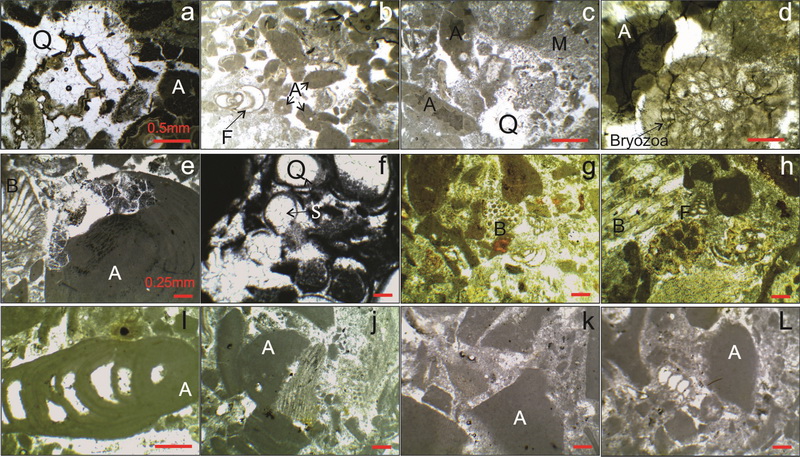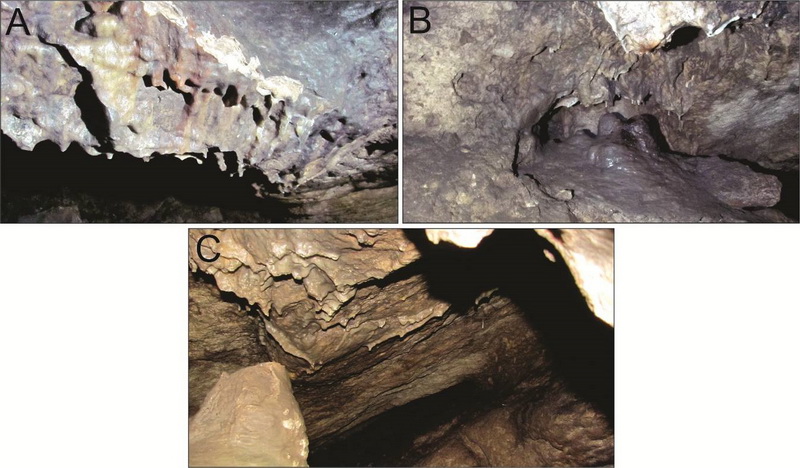| About | Maps and Graphics |
| Scientific Staff and Areas of Study | International Cooperation |
| Scientific Achievements | Publications |
Scientific Achievements
Main Results
1. For the first time, the milk-white radiolarites of Barremian age sandwiched by volcao-terrigenous deposits were described in Amasia ophiolite complex and subareal volcanic activity was documented. The red radiolarites covering the lavas of second area have Middle Oxfordian-Lower Kimmeridgian and Berriasian ages. In Erakh ofiolite mélange, the radiolites in contact with variolitic lavas have Upper Aalenian- Middle Bajocian age. Here in the second area the blocky radiolarites intercalated with pelagic limestones is dated Upper Valanginian. Thus, the submarine volcanic activity occurred in Late Aalenian-Middle Bajocian interval, while the accumulation of carbonate-silicite complex occurred in Late Valanginian.
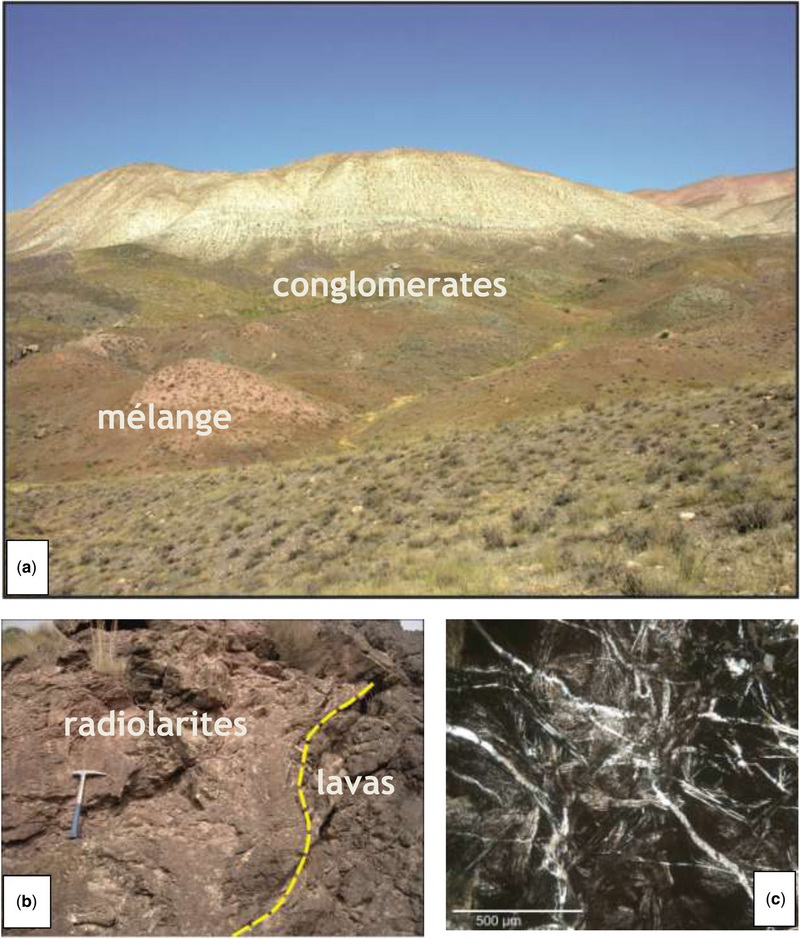
2. The Permian-Triassic boundary microbialites were peculiarly abundant on low-latitude shallow-marine carbonate shelves of central Tethyan continents. Armenia features particularly well preserved and diverse basal Triassic sponge-microbial build-ups (BTSMBs), which were not studied in detail. Here, the Chanakhchi section in southern Armenia is described petrographically and by means of stable isotope analyses. The Armenian BTSMBs formed in a distally open marine setting on a pelagic carbonate ramp in the course of two phases of microbial growth during the Induan (Lower Triassic). The BTSMBs are represented by predominantly thrombolitic but also dendrolitic and digitate stromatolite biostromes and mounds that vary in height between 5 cm to 12 m.
BTSMBs that formed during the second microbial growth phase revealed similar δ13C-values like the surrounding sediment. In contrast, the δ13C microbialite and δ13Csediment values from the BTSMBs and CCFs of the first growth phase show a difference of up to +2.3‰, suggesting a significant influence of photoautotrophy during microbially induced carbonate precipitation.
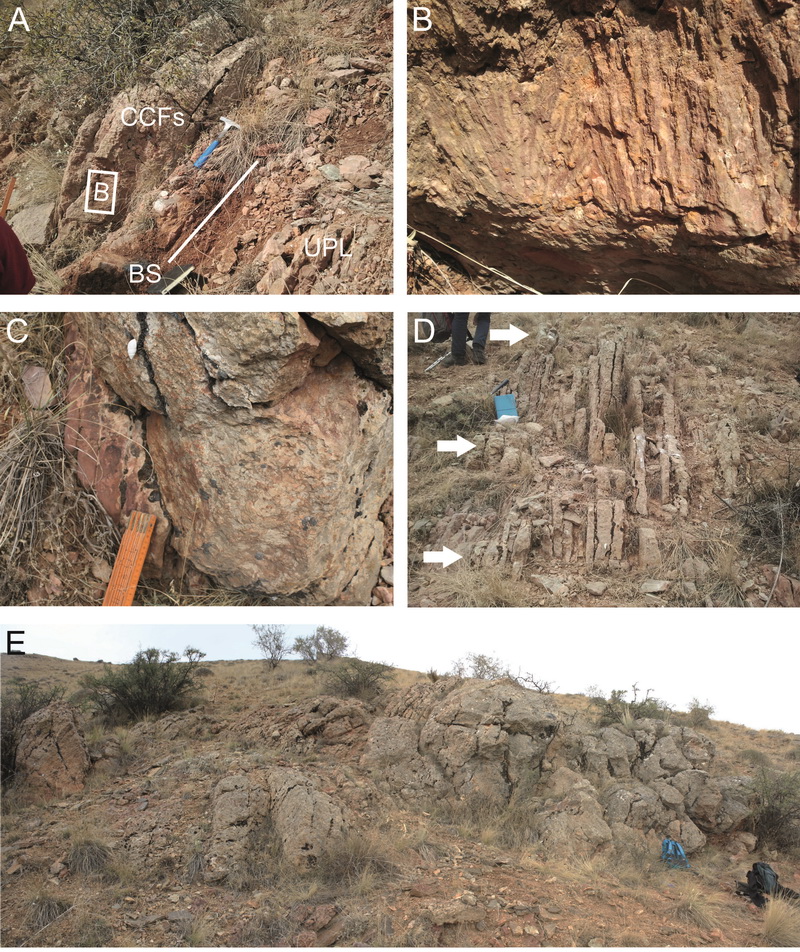
3. Together with the team of Geodynamics and geological hazards laboratory, the Quaternary sediments study of Shirak and Sevan basin was carried out. 10 sections were described in Shirak basin, their mineralogical and petrographic description was provided. Soft-sediment deformation structures (SSDs) are observed in Ani and Arapi formations in alluvial coarse-grained gravel, lacustrine sandy, silty, clayey, and clayey-diatomite layers of palaeo-Shirak basin. In this study SSDs were classified based on morphological features as contorted structures (simple convolute bedding, ball and pillow structures), load (flame structures). Spherical or semi-spherical structures are observed in clay, silty, sandy and gravel deposites. Gravel and pebble layer is growth like flame in upper silt layer. Flame structures are observed in sandy and silty deposits as well. They are formed by penetration of sandy sediments to silty deposits. The seismites are observed in different levels of lacustrine deposits: eight levels in the Ani and four-fives levels in Arapi unit. The existence of seismites is evidence for continuing tectonic activity (M≥5) that affects the Lake deposits.

4. The litho-stratigraphy of the two sections was examined in Noratus-Qanagegh area and the seismites were described.
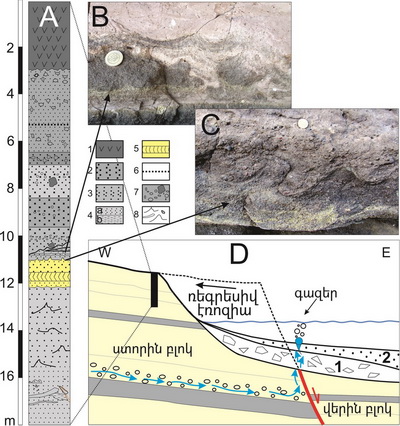
Legend for A: 1- trachyandesites, 2- coarse-grained sand, 3- medium-grained sand, 4- fine-grained sand (a), clay (b), 5- oblique lamination, 6-Mn contained layer, 7- pebbles, 8-seismites.

The age of higher black scoria was determined 2.30 +/-0.15Ma, according to K/Ar dating.
5. The lithological and structural peculiarities of diatomite rocks in Vorotan-Goris diatomite bearing basin were discovered. The concentrate (P2O5 absorption by plants) acquired as a result of enrichment of rocks containing new type of phosphorus also meets the standard requirements presented for the phosphorus fertilizers. Mineral raw material of biogenic-aragonite (mollusks) with 95% carbonate content was acquired in Akhuryan diatomite basin, where the carbonate content is 50-57% as a result of non-chemical treatment, while the non-dissolvable part percentage is 2.5-4%. The mentioned variety, which has a high solubility, can be used as food for agricultural animals, in case of non-chemical and not complicated treatment.
6. Microbial carbonates (originated by bacteria processes, including cyanobacteria, with algae and biota) from Martakert region (NE Artsakh) are studied, as well as the caves formed in the Upper Jurassic limestones (Karin Tak).

Pillows, domes constructions are formed in shallow environment and composed of sparry matrix of quartz and carbonate cement, microbial mat (clotted, peloidal), consisting of in situ branching algae (Thallus, Dasycladaceans?), growing bryozoans. Ostracods, foraminifers and detritus of few quantities are observed as well. The microbialites are characterized by a dark, micritic peloidal fabric with no internal lamination and are therefore classified as thrombolites (Ph.D. L. Sahakyan).
